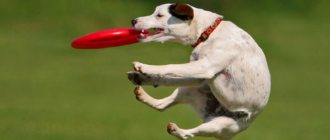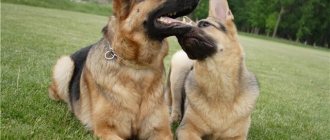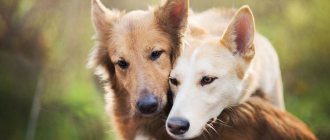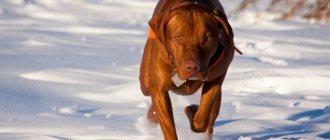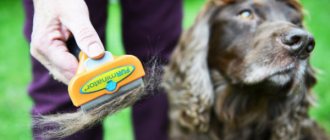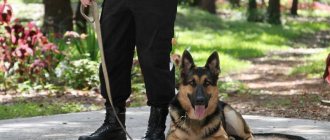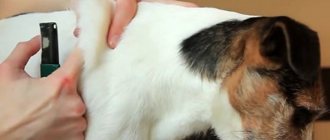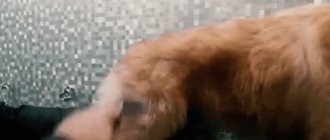Taking obedience courses together and participating in canine sports helps owners achieve a closer bond with their pets. With their help, it is possible to eradicate unwanted behavior and direct the four-legged hyperactivity in the right direction.
Due to the variety of possible options, the most difficult part is choosing the right discipline. Obedience for dogs often appears among them, but only a few know what it is and where it’s best to start in the absence of experience. You can find out the answers to both questions below.
Obedience for dogs - what is it?
The FCI, or international canine organization, recognizes that obedience for dogs is the most difficult obedience standard. The general training course takes about 3 years, provided that the exercises are regularly practiced several times a week.
INTERESTING!
In addition to the main sport, there is also an unrecognized variety of it - rally obedience. This is a speed competition where the animals must complete a course following exercises indicated on signs along the way.
History of the discipline
The origin of the discipline is England. Obedience began to gain popularity in the 1920s. What distinguished it from other types of canine sports was that, in addition to agility, participants had to demonstrate their obedience. The first national championship was held in 1950, and 40 years later competitions began to be held at the international level, that is, with the participation of other countries.
The rules and regulations for obedience approved by the FCI differ from those adopted in England. Because of this, the British approved a separate sport - English style obedience. It is carried out only at the national level.
“ Russian trainers joined the new sport in 1998, and in 2016, international obedience competitions were held in the Russian capital.
Basic principles
We can say that obedience for dogs is a complicated version of the Russian OKD. This type of training focuses on developing a mutual bond with the owner and performing a specific set of skills. The latter depend on the difficulty class.
To perform successfully in sports, a dog must perform exercises in a variety of conditions and with a variety of distractions. How to achieve this?
This is achieved by practicing exercises from the earliest stages in different places and under the most varied conditions. Try to start changing training locations as early as possible, as soon as the dog begins to understand what is required of it. In this case, the training should be based on the dog’s level of preparedness. Those. if he “knew” how to do some skills, for example, a 10 m complex, then in a new place (complication) we simplify the task (5 m) until the dog begins to perform it well. Sometimes you need to return to the very first stage (a treat in your hand, for example, and completely leading the dog by hand), if the work is very difficult.
For example:
Let's assign different levels of difficulty for the dog to different places of exercise:
Country house plot - 1 Yard in the city - 2 Park with people and dogs walking in the distance - 3 Dog playground - 4 Indoor exhibition - 5
Let’s number the different degrees of the dog’s preparedness in the side-by-side movement exercise.
10 steps - 1 20 steps - 2 30 steps - 3 40 steps - 4 50 steps - 5
Note: in this case, the degree of preparedness means that the dog maintains the correct position for the indicated number of steps, completely focused on the handler.
Then the lesson will be held in each place of difficulty in the appropriate mode:
In order for the skill to be securely fixed, there is the so-called. “rule of fifty” - if you have practiced an exercise in 50 different situations, you can consider it fixed. What are distracting factors for dogs, and what is the “difference” of situations for them?
Common Distractions
Surfaces
From childhood, a dog should be accustomed to different surfaces; ideally, before training begins, it should behave equally actively (play and offer to work) in any safe places.
- snow (of varying degrees of depth and looseness);
- grass (again, varying heights and densities; be careful on stubble);
- dirt;
- puddles;
- sand;
- asphalt (be careful with high jumps and sudden braking);
- carpet;
- sewer hatches and other things rattling underfoot;
- rustling newspapers and cardboard;
- swinging surfaces (a board under which something is placed, for example);
- terrain (slopes, elevations - both natural and artificial);
Weather
Different dogs react to the weather differently - some love frost, while others, on the contrary, refuse to leave the house in cold weather. There are heat-loving dogs, and there are heat-tolerant dogs. Most dogs don't like rain, but some dogs like to jump in puddles. Try to conduct training in any weather, at least so that you yourself know what working conditions your dog prefers. Take into account the safety of the weather for health and structure the training so that the dog enjoys working even in weather conditions it does not like.
Trainer's condition
This is one of the critical factors that greatly influences the dog’s performance in the ring. If you don't feel well, you move slower. If you are excited, move faster. When you are in a bad mood, you are less happy about your dog’s success. Ideally, during classes, you should do everything to change minimally externally due to your internal state. Some trainers are greatly influenced by the presence of spectators - train yourself by going out to train with your dog in a crowded place. This will help you learn to disconnect from the outside world and concentrate only on the dog, and the dog will learn to work with a handler who is less collected and calm than he is used to seeing in a secluded training area.
Change of group composition
When training in a group and/or with a trainer, a strong distraction is a change in the composition of the group (the appearance of new dogs or a complete change of group) and a change of trainer (steward). Your training should be aimed at ensuring that this does not cause problems in the dog’s work.
Field size
It also matters for dogs. On a larger field or stadium they tend to make more mistakes.
Place of classes
For a dog, even a spot at the next entrance will be a “new” place, if previously you only walked there on a leash to the place of walking. But at later stages of training, you should try to train in crowded and noisy places, in public places and in transport (as far as possible), at dog shows held in the hall, at competitions in various sports with dogs.
Distractions by exercise
Movement nearby
1) Surfaces underfoot. Dogs get very distracted when changing surfaces. 2) Various obstacles towards which the handler and the dog “seem” to be moving: a) physical (you have to push against walls and fences, walk close to trees, benches and people, etc.); b) “psychological” - go to what the dog wants or what he thinks we will do - to a barrier, to placed cones or lying toys, a bowl of food, agility equipment, a helper, etc. 3) Various objects in the hands; waving your arms or holding them “strangely”; kick something in front of you, etc. 4) Common distractions described above
Complex
1) Distractions around the area where the dog is working - scattered treats, dumbbells, toys 2) General distractions described above
Expulsion to the square
1) Indirect entry, including from different sides of the square relative to the handler’s position 2) Different types of lines indicating the boundaries of the square (lines filled with sawdust, for example, confused even experienced dogs) 3) Various distractions near the square: - toys - false targets - barrier - additional cones in the dog's field of vision - dumbbells - place of recall and/or complex near the square 4) General distractions described above
How does obedience differ from a general training course?
Some owners confuse OKD and obedience for dogs, believing that these are different names for the same discipline. In fact, they have 3 important differences:
- Possible level of competition. OKD takes place exclusively at the national level, that is, within the country.
- Requirements for participants and the severity of judging. OKD is less demanding on the quality of exercises, so even beginners can take it.
- Assessing the animal's level of trust in the trainer. OKD does not take into account the emotional state and desires of the dog. The only thing that matters is practicing the skill.
Thus, obedience aims to carry out commands without coercion and helps in establishing a trusting relationship with its pet.
Division into classes according to difficulty
Getting admission to international championships is very difficult. It is provided only to those who pass the exercises with excellent marks. Tasks for four-legged pets vary depending on the difficulty class:
- Obidience 1, or entry level. Includes the simplest exercises. The lower age limit for participants is 10 months, and in Russia it is 8 months.
- Obidience 2, or intermediate level. In addition to the age limit of 10 months, successful completion of the entry level is taken into account. The difficulty of the exercises increases.
- Obidience 3, or maximum level. Dogs must be at least 15 months old. The tasks at this level are the most difficult to complete, since four-legged animals that have successfully completed the 2 previous stages are allowed to participate in it. Competitions according to this standard are held between countries.
It was already mentioned above that it takes about 3 years to successfully complete obedience 1 and other classes. For this reason, only adult animals compete for the title of “world champion”.
How obedience competitions work
All rules and regulations regarding obedience are regulated by the FCI. In addition to a set of requirements for participants, they include a list of exercises at different levels and a system for evaluating results.
Rules and regulations
According to the rules, animals of any breed are allowed to compete. They must be non-aggressive, completely healthy and vaccinated. During estrus and in the last weeks before giving birth, participation is contraindicated due to the possible distraction of males and the threat to puppies.
Other important rules include the following:
- Prohibition on non-verbal (gesture) commands and rough treatment of pets.
- Touching an animal with the aim of directing it in the right direction or forcing it to perform a certain action.
- Using toys and treats for reward. Only praise is allowed, but strictly after completing the exercise.
The speed of walking next to the owner depends on the difficulty class, and the order of performing the exercises depends on the decision of the judges. The sequence they choose must be the same for all participants.
Exercises
The final grade is based on the results of completing a set of exercises. It includes:
- Group shrinkage for 2 minutes. All four-legged participants sit down on command, and their owners are temporarily removed from view.
- Laying down in a group with distraction for 4 minutes. It differs from the previous exercise not only in the command, but also in the presence of a distraction factor.
- Walking nearby without using ammunition. This takes into account the synchronicity of the movements of the pet and its owner.
- Practicing commands while walking nearby. The previous exercise is complicated by taking a sitting, lying or standing position when receiving the appropriate order.
- Calling with taking a lying or standing position as it approaches the owner. Performed from 25 meters.
- Departure in a certain direction with laying down and stopping. The pet performs the command “Lie down” 10 meters from the owner, and then goes to a pre-marked square after 25 meters and stops there on the command “Stand”.
- Importing an item. Of the 3 proposed items, the animal must bring only 1, chosen by the judges.
- Retrieval with overcoming a barrier up to 1 m high.
- Selecting an object with the owner's scent.
- Practicing the commands “Sit”, “Lie down” and “Stand” 15 meters from the owner. Changing positions is up to 5-6 times.
At the initial stages, all obedience exercises are divided into small elements and performed from reduced distances. Sampling by smell and stopping with command execution during calling are added from 2nd grade.
Judging
When assigning marks, judges take into account the correctness of the obedience exercises and the mood of the four-legged participant. The animal should be happy not only when the commands are being worked out, but also during the break.
Each task is assessed on a 10-point scale. If the opinions of the judges are different, then the arithmetic average goes into the final score.
IMPORTANT!
Points are deducted for mistakes and upon presentation of a penalty card. Yellow removes all 10 points, while red leads to immediate disqualification.
Exercise Evaluation
Each exercise is scored with one mark from a scale of 0 – 5 – 5½ – 6 – 6½ – 7 – 7½ – 8 – 8½ – 9 – 9½ – 10. That is, the maximum number of points for one exercise is 10, the minimum is 0. For errors and inaccuracies you may be penalized by 0.5 points or even have your results canceled entirely.
The referees also use red and yellow cards. A yellow card is a warning, but if the judge shows a yellow card, 10 points are deducted from the athlete; if the judge shows the card 2 times, disqualification. Red card - immediate disqualification
Which dogs should be obedience trained?
Having figured out that obedience for dogs is a course of obedience exercises, it remains to understand who might benefit from it. The answer to this question depends on the goals being pursued.
If you plan to seriously participate in obedience competitions and reach level 3, then it is best to choose a breed with a high level of intelligence. The best results are shown by border collies and other four-legged animals from Stanley Coran's rating.
In most cases, training is carried out with the aim of preparing for ZKS, agility and dog shows. Here you can limit yourself to only the first class of complexity.
The process of preparing for competitions
If your goal is to participate in obedience competitions, then, first of all, you should decide on a coach. It will help you master the first steps and establish contact with your pet.
Choosing a trainer or self-study
Self-training makes sense only at the initial level, where obedience exercises include practicing basic commands without sampling by smell and other difficulties. In all other cases, you will have to contact a dog handler. Classes are conducted only in individual form.
First steps
There is no need to wait 8-10 months. The first steps towards obedience include memorizing basic commands. It is recommended to get acquainted with them from 2.5-3 months, that is, from the moment the puppy appears in your home. If desired, your pet can be registered for UGS - a simplified version of OKD.
Step-by-step training
When performing obedience exercises, it is important to adhere to step-by-step training. Do not rush to burden the puppy with fetching and fetching until the position commands are reinforced.
Also try to avoid pressure. Exercise should be fun for your pet, so be sure to reward him for any success.
Don't try to master everything at once, trying to skip the first 2 classes. To begin with, achieve perfect completion of tasks at level 1 - and only then move on to more complex skills under the guidance of an experienced trainer.
How to choose the right trainer to train your dog?
Many owners are concerned with the question: “Where to start with obedience for dogs?” First of all, you need to choose a coach. Since there are no group classes, it is important to choose an instructor who has the experience and knowledge required.
Training in the skills of the first two categories can be carried out by the owner of the animal, regardless of its physical fitness. However, to train even the easiest standards, the help of a professional dog handler is recommended.
A professional trainer must be able to quickly and without coercion establish contact with the animal. If you wish, you can attend trial lessons or get acquainted with the work of a dog handler with other dogs.

